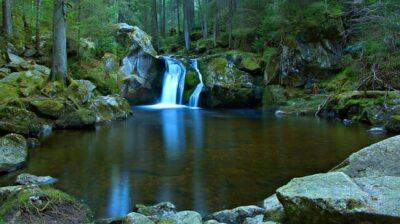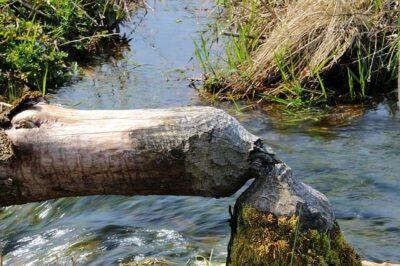
Check your local regulations for fishing methods, times and limits. Please make sure also to have your fishing license, too!
1. Crayfish
Where to find: On hot days, you can see them gliding across the rocky bottoms of creeks, lakes and ponds. They like to hide under logs and roots that grow along the banks, as well.
How to catch: Crayfish can be caught in a variety of methods: by trap, hook, net or by hand. Put them in a bucket without water or they will drown. I am a fan of looking under rocks. I can get 50 in less than two hours on a good day. Traps seem to work OK if you have a bunch out, but depending where you are, it may not be that successful. With a hook and bait, you can just drop the bait in front of them, and then lift your bait and shake off the “mud bug.” Nets may work if you put the net behind the crayfish and use a stick to tease it into your net.
How to clean: After catching your crayfish, sort through them. You don’t want to eat a dead crayfish — it could make you sick. Then just rinse them 3-4 times with a garden hose. Try to get off as much dirt as possible.
How to cook: Cooking crayfish can be as simple as sautéing in butter, shell and all. Some people like to make a “mud bug boil.” This means boiling your crayfish with Cajun seasonings. You also can peel the tail and use the meat as you would shrimp. After cooking, try tearing the heads off and sucking all the stuff inside. That is known as the crayfish butter. Yum!
2. Frogs
Where to find: Frogs can be found in the day, hiding in tall grasses and under banks. It’s much easier to find them at night. Best time is usually in the warmer months because the frogs are a little larger than in spring. Using a spotting light (red lenses can be used so frogs won’t see it), just shine along the water banks. They will signal you with shining eyes or by guiding you to them with their croaking call.
How to catch: Catching frogs is usually done with a gig. A gig is a spear with points to impale the frogs, then dump them into a covered bucket or net. As kids, we would just take hot-dog pokers and tape them to a long branch. You can buy commercially made frog gigs now. A few more ways to get them are with nets (nice because you can keep them alive to butcher in the morning), slingshot, 22 rifles with shot shell, bow and arrow, teasing with a spinner on fishing line or by hand.
Get The Essential Secrets Of The Most Savvy Survivalists In The World!
How to clean: Frogs do not need to be cleaned, just skinned. Up north, we only eat the rear legs.
- Make a shallow slit around the waste.
- Use pliers to grab the skin.
- Peel down like you’re taking off his pants.
- Cut through the spine where you made the initial cut.
- Cut off the feet.
- Dump the legs into a pail of ice water.
- Cook

How to cook: Most people like to bread and fry like you would chicken or fish. It’s also good in just about any soup or stew. Treat them like chicken wings.
3. Turtles
Where to find: Many people find turtles, specifically snapper turtles, to be a delicacy. You can find these guys in just about any body of water. Ponds are a favorite, so ask some pond owners, who will probably be glad to be rid of them. Rivers and creeks also hold snappers, so give them a try, too.
How to catch: The main way to catch snappers is with 3-inch turtle hooks and line, but you can also build a turtle trap. Turtle traps are just cages with a spring door. They check in but don’t check out. Hook and line is the preferable method. All you need is the 3-inch turtle hooks on the cord (I also use the cheap nylon) and some bait. Bait can be pieces of fish, liver or rotting meat. I know a few people who use road-killed groundhog chunks. I like to take some stocking material, put some liver in it, and then run my hook through the stocking material. This helps keep the bait on the line so fish won’t pick it off.
Basic turtle line uses about 10 feet of cord hook on one end and a stake or piece of rebar to anchor to the ground. In my state, I must tag each line with all my personal information, so check for your local regulations.
How to clean: I always leave turtles to sit in a tub of clean water for a week. I change it daily; you will get rid of that swampy muddy flavor turtle can have. Every time you butcher a turtle, you will get a little better.
Get the turtle out of the tank and on its back. Have someone pull the cord so that its head is pulled out. Separate the head from the body using a hatchet. Then, separate the bottom shell from the top with a hacksaw. Using a knife, separate the meat and skin.
You can find many other ways (air pressure or a water hose) to help skin your turtle. Just check online and you will see many other ways to get that precious meat out of that shell.
How to cook: Turtle can be used just like chicken. Soup is a good way to eat it, but breaded and fried will trick most into believing you are serving them chicken.
4. Eels
Where to find: You can find eels in rivers and creeks. As a child in Pennsylvania, I found them easily, but it’s been harder as time has passed. The Delaware river water gap still has a healthy stock of eel.
How to catch: Eels can be trapped in eel traps (commercially made) with a gig, such as the one for frogs and hook and line. I prefer hook and line with at least 20-pound fishing line. Not many freshwater fish can fight like eels. Once you have one on the line, get it in as quick as possible or it will tangle into rocks or sunken trees. They will eat just about anything from worms to cut-up fish.
How to clean:
- Get a 55-gallon drum and let them soak for a few days.
- Make sure they can’t get out of the tank.
- Take an eel out with the help of a towel for traction.
- Hammer a nail through its head into a post or tree.
- Put a small slit all around its neck.
- Use pliers to just pull down to strip it.
- Now you can gut it and use pruners to decapitate it.
How to cook: Eels are fantastic smoked; cut into chunks and breaded and fried is good enough for most people. Just don’t overcook or it will be tough as leather.
5. Water snails

Where to find: Freshwater snails can be found in most lakes and clean bodies of water. Just look close and you will be able to pick until your heart’s content!
How to catch: Just a hand is needed for these little guys.
How to clean:
- Boil them in water for 15 minutes.
- Rinse them in cold water.
- Repeat two other times for a total of 45 minutes of boiling.
How to cook: Just toss the boiled snails into some butter and garlic till warm. Season to taste using any herbs you like. Enjoy!
What creatures would you add to our list? What advice would you add on catching or cooking? Share your tips in the section below:








